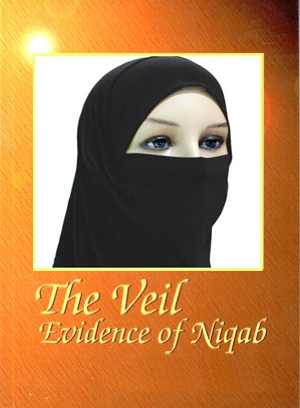Hub For Your Daily Islamic Insights 🕋 🕌

The Veil: Evidence of Niqab, Comprehensive guide on the practice and significance of niqab
Comprehensive guide on the practice and significance of niqab
Free
Delve into the rich history and profound significance of the niqab with 'The Veil: Evidence of Niqab'. This enlightening book provides well-researched evidence and thoughtful analysis on the cultural and religious roots of wearing the veil in Islamic tradition. An essential read for students, scholars, and anyone curious about diverse perspectives, it offers in-depth discussions, insightful commentary, and a respectful exploration of the niqab's role in modern society. Compact and easy to carry, this paperback edition features a sleek, professional cover design—perfect for personal libraries or classroom settings.
### The Veil: Evidence of Niqab – A Comprehensive Guide to the Practice and Significance of Niqab **Introduction** The niqab, a face veil worn by some Muslim women, is a symbol of modesty, faith, and cultural identity. This guide explores the niqab's historical roots, its religious significance, and its varying perceptions across different societies. **Historical Context** The practice of veiling for women is not confined to Islam. Historical records indicate that similar traditions existed in various civilizations throughout history. The niqab is often associated with Islamic teachings; however, its use has evolved significantly over time. Early instances of veiling can be traced back to ancient Mesopotamia and Persia, where women utilized such garments for both cultural and religious purposes. By the time of the advent of Islam in the 7th century, cultural norms around modesty had already been established. The Qur'an contains verses that encourage modest dress, but interpretations and applications of these guidelines have varied widely across different cultures and epochs. The specific practice of wearing the niqab has gained prominence in various Muslim communities, primarily influenced by local traditions, societal expectations, and interpretations of religious texts. **Understanding the Niqab** The niqab typically consists of a headscarf that covers the hair and neck, combined with a face veil that leaves only the eyes visible. Unlike the burqa, which covers the entire body and face, the niqab allows for a degree of visibility and is more common in certain Sunni communities, particularly in the Arabian Peninsula and parts of North Africa. **Religious Significance** For many women who choose to wear the niqab, the decision is deeply personal and rooted in their understanding of faith. The choice to don the niqab is often inspired by the desire to adhere to Islamic principles of modesty, as taught in the Qur'an and Hadith. While there is no explicit mention of the niqab in the Qur'an, references to female modesty are encapsulated in verses that mandate women to dress modestly and to draw their cloaks (khimar) over their bodies. Hadith literature—sayings and actions of the Prophet Muhammad—provides additional context, and interpretations vary, leading to diverse practices among Muslim women regarding veiling. ### Cultural Dimensions The significance of the niqab goes beyond religious obligation; it is also a component of cultural identity. The practices and acceptance of the niqab can vary significantly between different countries and communities: 1. **Middle Eastern Countries**: In Saudi Arabia, the niqab is commonly worn and reflects the conservative cultural values prevalent in society. Women may feel social pressure to adhere to this practice. 2. **North Africa**: In countries like Morocco and Tunisia, the niqab is also worn, although it is less common in urban areas compared to more rural settings. 3. **Western Countries**: In Western nations, the niqab has often become a focal point in discussions about immigration, cultural integration, and women’s rights. The visibility of the niqab can lead to diverse perceptions, from admiration to misunderstanding or even hostility. ### Personal Decisions and Challenges The decision to wear the niqab is often influenced by multiple factors, including familial traditions, peer influences, and personal convictions. For some women, it represents a direct manifestation of their faith and a form of empowerment. For others, the choice may be influenced by societal norms rather than a personal commitment to their religious beliefs. However, wearing the niqab can lead to various challenges, particularly in non-Muslim-majority countries. Issues such as discrimination, prejudiced attitudes, and societal pressure can make it difficult for women to navigate their daily lives while adhering to their choice of dress. The niqab often stirs debate over women's rights and freedom of choice, with advocates arguing that wearing the veil should be respected as a personal decision. On the other hand, critics express concerns over the implications of wearing such garments in contexts of societal integration and accessibility. ### The Niqab and Feminism The niqab has sparked conversations around feminism and women's liberation. Some argue that veiling serves to empower women by allowing them to take control over their bodies and how they present themselves. Others counter that it may perpetuate patriarchal structures by reinforcing traditional gender roles. These divergent perspectives highlight the complexity of women's experiences with the niqab and veiling practices. It's essential to acknowledge that feminism is not monolithic; many feminists advocate for the right of women to choose the niqab while critiquing the circumstances that compel some women to wear it. Global conversations around feminism continue to evolve, incorporating the voices and experiences of Muslim women who navigate the nuances of identity, faith, and gender. ### Modern Discourse The contemporary discourse surrounding the niqab often intersects with themes of globalization, secularism, and cultural identity. Various countries have introduced laws governing the wearing of veils in public spaces, citing security and social integration concerns while others strive to promote inclusion and freedom of expression. Political debates frequently emerge in contexts where the niqab becomes emblematic of broader issues of race, religion, and identity. For instance, the niqab was at the center of discussions during immigration policies and legal proceedings in several European countries. These conversations contribute to the evolving understanding of multiculturalism and individual rights in increasingly diverse societies. ### Conclusion The niqab remains a complex and multifaceted practice imbued with personal, cultural, and religious significance. For many women, the act of wearing the niqab signifies a deep commitment to their faith and offers a means of expressing their identity. Simultaneously, the niqab poses challenges and ignites debates concerning femininity, freedom, and the multitudes of experiences within the Muslim community. The key takeaway is to approach conversations around the niqab with sensitivity and respect, acknowledging the diversity of perspectives and the autonomy of women in making their own choices regarding their bodies and beliefs.
